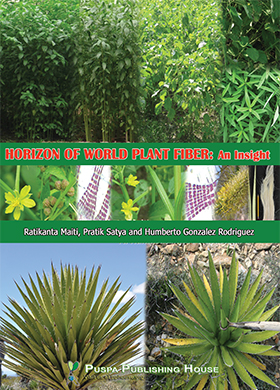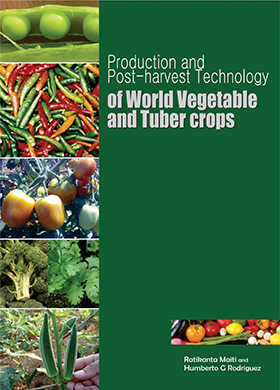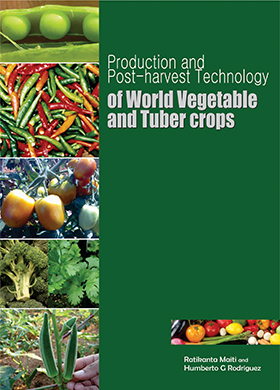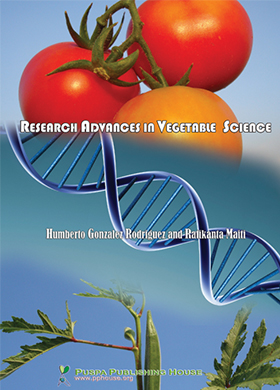Table 1: Bio-agents deposited in National/ International collection /culture/ GenBank
Table 2: Morphological descriptors used in characterization of Trichoderma sp.
Table 2: Continue...
Table 3: Cultural observations of the selected Trichoderma isolates collected from Kanpur and different locations of Uttar Pradesh, India
Table 3: Continue...
Figure 1: Cultural and morphological observations of Trichoderma spp used
Figure 1: Continue...
Figure 1: Continue...
Table 4: Describing the ISTH TrichOKEY and TrichoMARK results for all eighteen Trichoderma species
Table 4: Continue...
Table 4: Continue...
Figure 2: The evolutionary history (Phylogram) was inferred using nearly complete ITS sequences (~600 bp) using ITS 1 and 4 primers from 18 Trichoderma spp. and available NCBI sequences, constructed by Neighbour Joining method (Saitu and Nei, 1987)
Table 1: Bio-agents deposited in National/ International collection /culture/ GenBank
Table 2: Morphological descriptors used in characterization of Trichoderma sp.
Table 2: Continue...
Table 3: Cultural observations of the selected Trichoderma isolates collected from Kanpur and different locations of Uttar Pradesh, India
Table 3: Continue...
Figure 1: Cultural and morphological observations of Trichoderma spp used
Figure 1: Continue...
Figure 1: Continue...
Table 4: Describing the ISTH TrichOKEY and TrichoMARK results for all eighteen Trichoderma species
Table 4: Continue...
Table 4: Continue...
Figure 2: The evolutionary history (Phylogram) was inferred using nearly complete ITS sequences (~600 bp) using ITS 1 and 4 primers from 18 Trichoderma spp. and available NCBI sequences, constructed by Neighbour Joining method (Saitu and Nei, 1987)
Table 1: Bio-agents deposited in National/ International collection /culture/ GenBank
Table 2: Morphological descriptors used in characterization of Trichoderma sp.
Table 2: Continue...
Table 3: Cultural observations of the selected Trichoderma isolates collected from Kanpur and different locations of Uttar Pradesh, India
Table 3: Continue...
Figure 1: Cultural and morphological observations of Trichoderma spp used
Figure 1: Continue...
Figure 1: Continue...
Table 4: Describing the ISTH TrichOKEY and TrichoMARK results for all eighteen Trichoderma species
Table 4: Continue...
Table 4: Continue...
Figure 2: The evolutionary history (Phylogram) was inferred using nearly complete ITS sequences (~600 bp) using ITS 1 and 4 primers from 18 Trichoderma spp. and available NCBI sequences, constructed by Neighbour Joining method (Saitu and Nei, 1987)
Table 1: Bio-agents deposited in National/ International collection /culture/ GenBank
Table 2: Morphological descriptors used in characterization of Trichoderma sp.
Table 2: Continue...
Table 3: Cultural observations of the selected Trichoderma isolates collected from Kanpur and different locations of Uttar Pradesh, India
Table 3: Continue...
Figure 1: Cultural and morphological observations of Trichoderma spp used
Figure 1: Continue...
Figure 1: Continue...
Table 4: Describing the ISTH TrichOKEY and TrichoMARK results for all eighteen Trichoderma species
Table 4: Continue...
Table 4: Continue...
Figure 2: The evolutionary history (Phylogram) was inferred using nearly complete ITS sequences (~600 bp) using ITS 1 and 4 primers from 18 Trichoderma spp. and available NCBI sequences, constructed by Neighbour Joining method (Saitu and Nei, 1987)
Table 1: Bio-agents deposited in National/ International collection /culture/ GenBank
Table 2: Morphological descriptors used in characterization of Trichoderma sp.
Table 2: Continue...
Table 3: Cultural observations of the selected Trichoderma isolates collected from Kanpur and different locations of Uttar Pradesh, India
Table 3: Continue...
Figure 1: Cultural and morphological observations of Trichoderma spp used
Figure 1: Continue...
Figure 1: Continue...
Table 4: Describing the ISTH TrichOKEY and TrichoMARK results for all eighteen Trichoderma species
Table 4: Continue...
Table 4: Continue...
Figure 2: The evolutionary history (Phylogram) was inferred using nearly complete ITS sequences (~600 bp) using ITS 1 and 4 primers from 18 Trichoderma spp. and available NCBI sequences, constructed by Neighbour Joining method (Saitu and Nei, 1987)
Table 1: Bio-agents deposited in National/ International collection /culture/ GenBank
Table 2: Morphological descriptors used in characterization of Trichoderma sp.
Table 2: Continue...
Table 3: Cultural observations of the selected Trichoderma isolates collected from Kanpur and different locations of Uttar Pradesh, India
Table 3: Continue...
Figure 1: Cultural and morphological observations of Trichoderma spp used
Figure 1: Continue...
Figure 1: Continue...
Table 4: Describing the ISTH TrichOKEY and TrichoMARK results for all eighteen Trichoderma species
Table 4: Continue...
Table 4: Continue...
Figure 2: The evolutionary history (Phylogram) was inferred using nearly complete ITS sequences (~600 bp) using ITS 1 and 4 primers from 18 Trichoderma spp. and available NCBI sequences, constructed by Neighbour Joining method (Saitu and Nei, 1987)
Table 1: Bio-agents deposited in National/ International collection /culture/ GenBank
Table 2: Morphological descriptors used in characterization of Trichoderma sp.
Table 2: Continue...
Table 3: Cultural observations of the selected Trichoderma isolates collected from Kanpur and different locations of Uttar Pradesh, India
Table 3: Continue...
Figure 1: Cultural and morphological observations of Trichoderma spp used
Figure 1: Continue...
Figure 1: Continue...
Table 4: Describing the ISTH TrichOKEY and TrichoMARK results for all eighteen Trichoderma species
Table 4: Continue...
Table 4: Continue...
Figure 2: The evolutionary history (Phylogram) was inferred using nearly complete ITS sequences (~600 bp) using ITS 1 and 4 primers from 18 Trichoderma spp. and available NCBI sequences, constructed by Neighbour Joining method (Saitu and Nei, 1987)
Table 1: Bio-agents deposited in National/ International collection /culture/ GenBank
Table 2: Morphological descriptors used in characterization of Trichoderma sp.
Table 2: Continue...
Table 3: Cultural observations of the selected Trichoderma isolates collected from Kanpur and different locations of Uttar Pradesh, India
Table 3: Continue...
Figure 1: Cultural and morphological observations of Trichoderma spp used
Figure 1: Continue...
Figure 1: Continue...
Table 4: Describing the ISTH TrichOKEY and TrichoMARK results for all eighteen Trichoderma species
Table 4: Continue...
Table 4: Continue...
Figure 2: The evolutionary history (Phylogram) was inferred using nearly complete ITS sequences (~600 bp) using ITS 1 and 4 primers from 18 Trichoderma spp. and available NCBI sequences, constructed by Neighbour Joining method (Saitu and Nei, 1987)
Table 1: Bio-agents deposited in National/ International collection /culture/ GenBank
Table 2: Morphological descriptors used in characterization of Trichoderma sp.
Table 2: Continue...
Table 3: Cultural observations of the selected Trichoderma isolates collected from Kanpur and different locations of Uttar Pradesh, India
Table 3: Continue...
Figure 1: Cultural and morphological observations of Trichoderma spp used
Figure 1: Continue...
Figure 1: Continue...
Table 4: Describing the ISTH TrichOKEY and TrichoMARK results for all eighteen Trichoderma species
Table 4: Continue...
Table 4: Continue...
Figure 2: The evolutionary history (Phylogram) was inferred using nearly complete ITS sequences (~600 bp) using ITS 1 and 4 primers from 18 Trichoderma spp. and available NCBI sequences, constructed by Neighbour Joining method (Saitu and Nei, 1987)
Table 1: Bio-agents deposited in National/ International collection /culture/ GenBank
Table 2: Morphological descriptors used in characterization of Trichoderma sp.
Table 2: Continue...
Table 3: Cultural observations of the selected Trichoderma isolates collected from Kanpur and different locations of Uttar Pradesh, India
Table 3: Continue...
Figure 1: Cultural and morphological observations of Trichoderma spp used
Figure 1: Continue...
Figure 1: Continue...
Table 4: Describing the ISTH TrichOKEY and TrichoMARK results for all eighteen Trichoderma species
Table 4: Continue...
Table 4: Continue...
Figure 2: The evolutionary history (Phylogram) was inferred using nearly complete ITS sequences (~600 bp) using ITS 1 and 4 primers from 18 Trichoderma spp. and available NCBI sequences, constructed by Neighbour Joining method (Saitu and Nei, 1987)
Table 1: Bio-agents deposited in National/ International collection /culture/ GenBank
Table 2: Morphological descriptors used in characterization of Trichoderma sp.
Table 2: Continue...
Table 3: Cultural observations of the selected Trichoderma isolates collected from Kanpur and different locations of Uttar Pradesh, India
Table 3: Continue...
Figure 1: Cultural and morphological observations of Trichoderma spp used
Figure 1: Continue...
Figure 1: Continue...
Table 4: Describing the ISTH TrichOKEY and TrichoMARK results for all eighteen Trichoderma species
Table 4: Continue...
Table 4: Continue...
Figure 2: The evolutionary history (Phylogram) was inferred using nearly complete ITS sequences (~600 bp) using ITS 1 and 4 primers from 18 Trichoderma spp. and available NCBI sequences, constructed by Neighbour Joining method (Saitu and Nei, 1987)
Table 1: Bio-agents deposited in National/ International collection /culture/ GenBank
Table 2: Morphological descriptors used in characterization of Trichoderma sp.
Table 2: Continue...
Table 3: Cultural observations of the selected Trichoderma isolates collected from Kanpur and different locations of Uttar Pradesh, India
Table 3: Continue...
Figure 1: Cultural and morphological observations of Trichoderma spp used
Figure 1: Continue...
Figure 1: Continue...
Table 4: Describing the ISTH TrichOKEY and TrichoMARK results for all eighteen Trichoderma species
Table 4: Continue...
Table 4: Continue...
Figure 2: The evolutionary history (Phylogram) was inferred using nearly complete ITS sequences (~600 bp) using ITS 1 and 4 primers from 18 Trichoderma spp. and available NCBI sequences, constructed by Neighbour Joining method (Saitu and Nei, 1987)
Table 1: Bio-agents deposited in National/ International collection /culture/ GenBank
Table 2: Morphological descriptors used in characterization of Trichoderma sp.
Table 2: Continue...
Table 3: Cultural observations of the selected Trichoderma isolates collected from Kanpur and different locations of Uttar Pradesh, India
Table 3: Continue...
Figure 1: Cultural and morphological observations of Trichoderma spp used
Figure 1: Continue...
Figure 1: Continue...
Table 4: Describing the ISTH TrichOKEY and TrichoMARK results for all eighteen Trichoderma species
Table 4: Continue...
Table 4: Continue...
Figure 2: The evolutionary history (Phylogram) was inferred using nearly complete ITS sequences (~600 bp) using ITS 1 and 4 primers from 18 Trichoderma spp. and available NCBI sequences, constructed by Neighbour Joining method (Saitu and Nei, 1987)
People also read
Research Article
Effect of Different Levels of Pruning on Quality of Custard Apple (Annona squmosa L.)
S. R. Kadam, R. M. Dheware and P. S. UradeCustard apple (Annona squamosa L.), pruning levels, treatments, quality
Published Online : 01 Oct 2018
Full Research
Integrated Nutrient Management on Growth and Productivity of Rapeseed-mustard Cultivars
P. K. Saha, G. C. Malik, P. Bhattacharyya and M. BanerjeeNutrient management, variety, rapeseed-mustard, seed yield
Published Online : 07 Apr 2015
Research Article
Constraints Perceived by the Farmers in Adoption of Improved Ginger Production Technology- a Study of Low Hills of Himachal Pradesh
Sanjeev Kumar, S. P. Singh and Raj Rani SharmaConstraints, ginger, mean percent score, schedule
Published Online : 27 Dec 2018
Review Article
Morphological, Physiological and Biochemical Response to Low Temperature Stress in Tomato (Solanum lycopersicum L.): A Review
D. K. Yadav, Yogendra K. Meena, L. N. Bairwa, Uadal Singh, S. K. Bairwa1, M. R. Choudhary and A. SinghAntioxidant enzymes, morphological, osmoprotectan, physiological, ROS, tomato
Published Online : 31 Dec 2021
Research Article
Social Structure of Mizo Village: a Participatory Rural Appraisal
Lalhmunmawia and Samares Kumar DasSocial structure, Mizoram, Mizo village, PRA
Published Online : 05 Mar 2018
Research Article
Traditional Knowledge on Uncultivated Green Leafy Vegetables (UCGLVS) Used in Nalgonda District of Telangana
Kanneboina Soujanya, B. Anila Kumari, E. Jyothsna and V. Kavitha KiranNutritious, traditional knowledge, uncultivated green leafy vegetable
Published Online : 30 Jul 2021
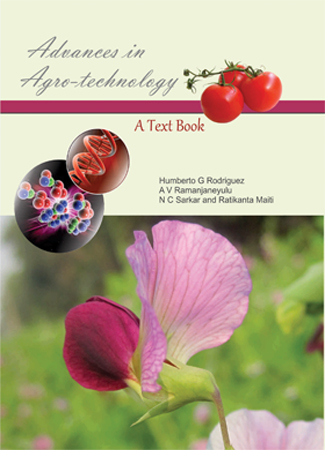
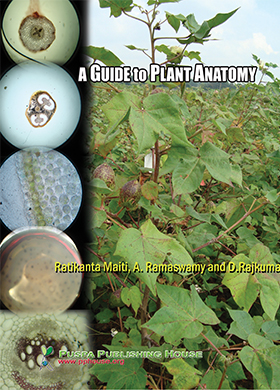
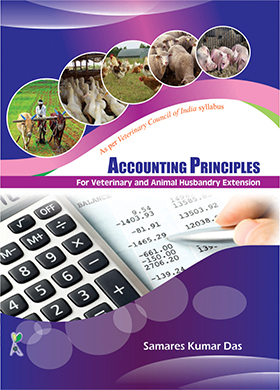
.jpg)
.jpg)


